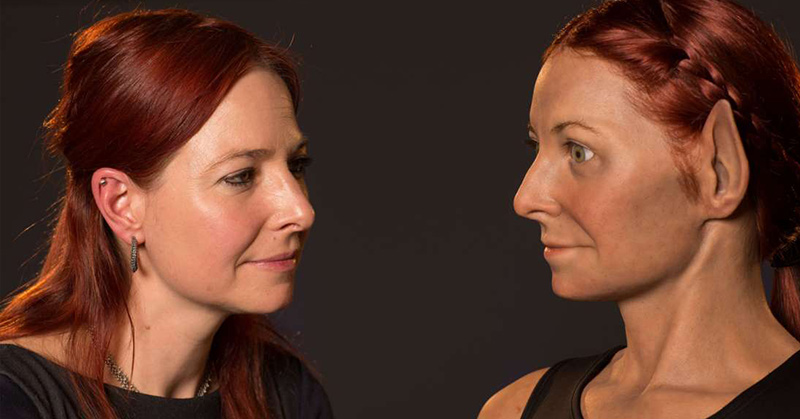Alice Roberts, an anatomist based in the United Kingdom, has been vocal about the imperfections of the human body. “I have often opined, in talks and in print, about what a hodge-podge of assembled parts the human body is,” Roberts says on her website [1]. “There are so many incompatible constraints on the design of individual elements that some of them end up failing long before each of us shuffles off this mortal coil—and others are just plain untidy.”
So when she was challenged to create a replica that fixed all the issues she had with the human body in three months’ time, Roberts got to work. With the assistance of Scott Eaten, an anatomical artist, and Sangeet Prabhaker, a special effects designer, Roberts brought to life a sculptured version of herself that’s now available to be seen at the Science Museum in London. Her design corrects what she perceives as flaws on the human body, her inspiration coming from other animals, and not just mammals. Here’s what she changed about human anatomy, calling her version the “Perfect Body”.
Ostrich Legs

Like humans, ostriches only use two legs to walk. However, Roberts says the human knee leaves too much room for error and often fails, so she borrowed legs from the ostrich for her replica. Roberts says that muscle mass lower on human legs makes them more inefficient, while muscles in ostrich legs move closer to the body, letting the feet be “light and easy to move” while large tendons provide adequate shock absorption.
Chimpanzee Spine

Our spine also received a redesign. While Roberts says our spine has its advantages, the lumbar vertebrae—which make up our lower spine—are under a lot of stress [2]. As we age, this stress can result in herniated discs, which happens when the cushion between each of our vertebrae is damaged and can result in pain, numbness, or weakness [3]. Roberts says the spines of chimpanzees are a bit sturdier, and so she used them to make her perfect body. Chimpanzee pelvises provide extra support and stabilization for the spine, although that would mean we’d be doing away with our waists. But for more spine support and protection, it’s worth it, right?
Dog Heart

Roberts designed her new heart to be more like dogs and guinea pigs. Why? To avoid the blockages that happen in a heart attack. So our heart has two coronary arteries that give it blood—but the links between them are “so small as to be practically non-existent”, according to Roberts. If one is blocked, the heart can’t get oxygen and so will die [4]. However, dogs and guinea pigs, among other animals, have more links between the arteries. What this means is that if one becomes blocked, the other artery can just take over the blood supply. Pretty cool, right?
Squid Skin

Lighter skin is more likely to sunburn and is subject to skin cancer, while darker skin doesn’t provide as adequate vitamin D production. So Roberts was in a bit of a pickle about what to do with our human skin, which needs sun to produce vitamin D, but not so much as to produce negative effects like sunburn and skin cancer. So what did she do? She says changing between pale and dark skin would allow her to ensure she was getting enough vitamin D in the winter, but protection in the summer. So she gave her replica skin from cephalopods—which include squid and octopuses [5].
Bird Lungs

Roberts says there is an “obvious design flaw” in the way our airway is constructed. Our airway (also referred to as our windpipe) separates into two tubes that enter the lungs [6] This is a “short but important section” that the airway and passage for food share, according to Roberts. While air goes into the lungs, food is essentially going the other way, down your esophagus. As everyone has experienced at some point in their lifetime, this allows food to go down “the wrong way”, as it’s commonly referred to. Roberts says that to avoid choking, she separated the airway and the passage for food completely, which, after choking on my own saliva at countless points throughout my life—usually in proper social situations—I have to admit this makes sense.
Roberts also borrowed bird lungs for our oxygen setup. In a human’s lungs, the airflow is bidirectional, meaning that our air comes in and goes out the same way. Birds, however, draw air into air sacs in their abdomen and chest, which contract to allow airflow through the lungs in just one direction. This setup makes absorbing oxygen and expelling carbon dioxide much more efficient, according to Roberts. So the new her has a pair of, apparently highly efficient, bird lungs.
Cat Ears

It’s well-documented that we lose the ability to hear high frequency as we age [7]. Eventually, the hearing loss will progress to lower frequencies, and it can’t be restored. To remedy this, Roberts says that instead of looking to restore the tiny hair cells in our inner ears, she would simply amplify the sound we initially receive, so she borrowed ears from a cat (although, admittedly, they look they bat ears to me).
Octopus Eyes

Roberts says our eyes have evolved as the result of our embryonic development, creating a “backward” retina, in which the light receptors are in the rear of the eye. This creates nerve fibers that have to meet where they go through the eye, creating a natural blind spot. Our brain compensates for the blind spot so we don’t really know it’s there, but Roberts says she wanted to avoid the blind spot altogether. To improve humans’ eyesight, she made the eyes larger and borrowed the anatomy of the eyes from octopuses, which have their eyes wired a bit differently to avoid blind spots.
Marsupial Pouch

When you look at Roberts’ “perfect” version of herself, one cannot help but notice the baby sticking out of a pouch on her stomach, much like a kangaroo. Indeed, Roberts borrowed the idea of a marsupial birth to ease the burden of childbirth on the human body. These animals give birth to live young, but the embryo continues to develop for weeks or months in the pouch, meaning they have a short gestation time—where the baby develops in the body. The babies still nurse from in the pouch and develop accordingly [8]. It looks weird, but Roberts said she received a huge response on Twitter in regards to childbirth when asking people what they wanted to change on the human body.
Learn More About the “Perfect Body”

Although I somehow doubt we’ll be seeing humans taking on these changes anytime soon, Roberts’ ideas are certainly logical, fascinating, and, as she would have us think, an improvement over our current bodies. If you want to check out more about Roberts’ project and ideas, BBC has released a documentary about her—very cool but a bit visually unsettling—project.

